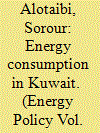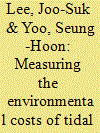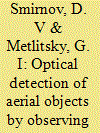|
|
|
Sort Order |
|
|
|
Items / Page
|
|
|
|
|
|
|
| Srl | Item |
| 1 |
ID:
132682


|
|
|
|
|
| Publication |
2014.
|
| Summary/Abstract |
Coal-fired power plants in China have emitted multiple pollutants including sulfur dioxide, nitrogen oxides and fine particulates, contributing to serious environmental impairments and human health issues. To meet ambient air quality standards, the installation of effective pollution control technologies are required and consequently, the cost of installing or retrofitting control technologies is an important economic and political concern. A multi-pollutant control cost model, CoST CE, is developed to calculate the cost of multi-pollutant control strategies in the Yangtze River Delta region (YRD) of China, adopting an LP algorithm to optimize the sorting of control technology costs and quickly obtain a solution. The output shows that total costs will increase along with emission abatement. Meanwhile, the slope becomes steeper as greater emission reductions are pursued, due to the need to install highly effective, but expensive, technologies like SCR and FF. Moreover, it is evident that the cost curve shapes, maximum abatement potential and total cost for the three provinces in the YRD region are quite different due to differences in power plant type and technologies, current emission levels and existing pollution controls. The results from this study can aid policy makers to develop cost-effective control strategies for the power sector.
|
|
|
|
|
|
|
|
|
|
|
|
|
|
|
|
| 2 |
ID:
103607


|
|
|
|
|
| Publication |
2011.
|
| Summary/Abstract |
In Kuwait, the consumption of oil, the country's main source of energy, is increasing year by year. In addition to the harsh climate and the rapid economic and construction growth in the country, there are further aspects of energy inefficiency. While 10% of the produced energy was being consumed locally in 1980, this percentage increased to 20% in 2005 and is expected to reach 40% by 2015. If this situation continues, the country will be forced to increase production or reduce exportation. Both options will cause serious problems to the country in meeting future energy demands due to its dependence on oil as a source of income, shortages of other energy resources, and the environmental care of the country.
In this work, we assess the energy situation in Kuwait and its historical, current, and future conditions with a focus on the power plant sector, as it is the major consumer of energy in the country.
Finally, an attempt is made to briefly describe the most realistic and efficient electricity production solutions available and to discuss other alternative resources such as nuclear, solar, and wind energy.
|
|
|
|
|
|
|
|
|
|
|
|
|
|
|
|
| 3 |
ID:
124224


|
|
|
|
|
| Publication |
2013.
|
| Summary/Abstract |
This study attempts to examine the natural gas fired power plants in Iran. The required data from natural gas fired power plants were gathered during 2008. The characteristics of thirty two gas turbine power plants and twenty steam power plants have been measured. Their emission factor values were then compared with the standards of Energy Protection Agency, Euro Union and World Bank. Emission factors of gas turbine and steam power plants show that gas turbine power plants have a better performance than steam power plants. For economic analysis, fuel consumption and environmental damages caused by the emitted pollutants are considered as cost functions; and electricity sales revenue are taken as benefit functions. All of these functions have been obtained according to the capacity factor. Total revenue functions show that gas turbine and steam power plants are economically efficient at 98.15% and 90.89% of capacity factor, respectively; this indicates that long operating years of power plants leads to reduction of optimum capacity factor. The stated method could be implemented to assess the economic status of a country's power plants where as efficient capacity factor close to one means that power plant works in much better condition.
|
|
|
|
|
|
|
|
|
|
|
|
|
|
|
|
| 4 |
ID:
092753


|
|
|
|
|
| Publication |
2009.
|
| Summary/Abstract |
Coal-fired power plants enjoy a significant advantage relative to gas plants in terms of cheaper fuel cost. This advantage may erode (or turn into disadvantage) depending on CO2 emission allowance price. Financial risks are further reinforced when the price of electricity is determined by natural gas-fired plants' marginal costs. We aim to empirically assess the risks in EU coal plants' margins up to the year 2020. Parameter values are derived from actual market data. Monte Carlo simulation allows compute the expected value and risk profile of coal plants' earnings. Future allowance prices may spell significant risks on utilities' balance sheets.
|
|
|
|
|
|
|
|
|
|
|
|
|
|
|
|
| 5 |
ID:
127249


|
|
|
|
|
| Publication |
2014.
|
| Summary/Abstract |
This study analyses battery electric vehicles (BEVs) in the future German power system and makes projections of the BEVs hourly load profile by car size ('mini', 'small', 'compact' and 'large'). By means of a power plant dispatching optimisation model, the study assesses the optimal BEV charging/discharging strategies in grid-to-vehicle (G2V) and vehicle-to-grid (V2G) schemes. The results show that the 2% rise in power demand required to power these BEVs does not hamper system stability provided an optimal G2V scheme is applied. Moreover, such BEV deployment can contribute to further integrating wind and solar power generation. Applying a V2G scheme would increase the capacity factors of base and mid-load power plants, leading to a higher integration of intermittent renewables and resulting in a decrease in system costs. However, the evaluation of the profitability of BEVs shows that applying a V2G scheme is not a viable economic option due to the high cost of investing in batteries. Some BEV owners would make modest profits (€6 a year), but a higher number would sustain losses, for reasons of scale. For BEVs to become part of the power system, further incentives are necessary to make the business model attractive to car owners
|
|
|
|
|
|
|
|
|
|
|
|
|
|
|
|
| 6 |
ID:
092731


|
|
|
|
|
| Publication |
2009.
|
| Summary/Abstract |
Korea is considering the construction of a tidal power plant (TPP) at Garolim Bay. However, as the construction of the Garolim TPP (GTPP) is expected to entail some environmental damage, it has become an increasingly important topic for public debate. Using a choice experiment (CE) approach, this study attempts to measure the economic cost that results from the environmental damage caused by the construction of GTPP. The CE is used to measure the environmental costs of individual attributes, including the reduction in the area of the tidal flat, the degradation of seawater quality, and the destruction of marine life. The results indicate that the annual willingness to pay (WTP) per household for mitigating the environmental damage that results from the worst-possible situation in relation to the present situation is about 96,042 Korean won (USD 101.1) in the seven biggest cities (off-site regions) and 18,584 Korean won (USD 19.6) in Seosan and Taean (on-site regions). This study is expected to provide policy-makers with quantitative information that will be useful to decide whether or not GTPP should be constructed.
|
|
|
|
|
|
|
|
|
|
|
|
|
|
|
|
| 7 |
ID:
133326


|
|
|
|
|
| Publication |
2014.
|
| Summary/Abstract |
The authors put forward an alternative method to detect and recognize aerial objects by observing their condensation trails (contrail and vapor trails) through multichannel optoelectronic system (MOES)
|
|
|
|
|
|
|
|
|
|
|
|
|
|
|
|
| 8 |
ID:
092851


|
|
|
|
|
| Publication |
2009.
|
| Summary/Abstract |
Non-utility power plants can competitively participate in open electricity market to reduce operational costs but in the absence of pollution charges or emissions trading such generators are tempted to cause greater pollution for profit maximization. This paper presents a solution that incorporates pollution charges for nitrogen oxides and sulphur dioxide emissions in line with existing national environmental quality standards and a new carbon dioxide emissions trading mechanism. A novel approach has been used for allocation of allowable emissions that favors efficiently fuelled and environmentally friendly operation for maximizing profit. Impact of proposed carbon trading on economical utilization of enormous indigenous coal reserves has been analyzed and determined to be acceptable. Software developed in this paper, harnessing Sequential Quadratic Programming capabilities of Matlab, is shown to be adequate simulation tool for various emissions trading schemes and an useful operational decision making tool for constrained non-linear optimization problem of a non-utility power plant.
|
|
|
|
|
|
|
|
|
|
|
|
|
|
|
|
|
|
|
|
|